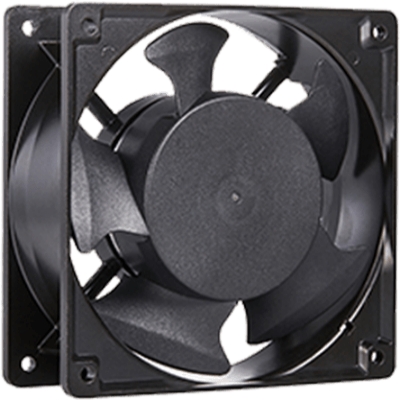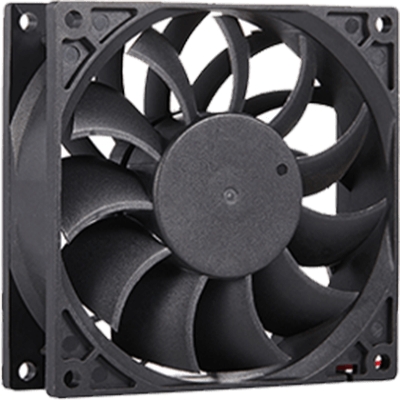Axial fans are important in industrial and commercial settings for maintaining airflow and cooling. They move air along the axis of rotation to ventilate spaces, cool equipment, and regulate temperature.
When selecting an axial fan, you'll need to choose between AC (Alternating Current) and DC (Direct Current) options. Although both serve similar purposes, each has its own strengths and weaknesses, making them better for different uses.
In this article, we'll compare AC and
DC axial fans, explain how they work, and highlight their key features. We'll also show how choosing the right fan can improve energy efficiency, reduce costs, and increase system reliability.
What Are Axial Fans?
Axial fans are a type of fan where air is moved parallel to the axis of rotation. These fans consist of blades that rotate to push air through the fan housing, creating airflow. Their design is simple yet effective, making them one of the most commonly used fan types in various industries, including HVAC systems, automotive applications, and computer cooling.
Axial fans can be powered by either AC or DC electricity. The main difference between AC and DC axial fans lies in the type of electrical current that powers the fan's motor, which in turn affects the fan's performance, energy efficiency, and other features.
AC axial fans use alternating current (AC) to operate. AC power is the standard electrical supply in most commercial and industrial settings, meaning these fans are designed to work directly with the power grid without needing any additional adapters or power conversion.
How AC Axial Fans Work
In an AC axial fan, the motor spins with the alternating current, creating a rotational movement that moves air through the fan blades. AC motors typically run at fixed speeds, although external controllers can adjust the speed to some extent.
Key Features of AC Axial Fans
High Airflow Capacity: AC axial fans are known for their ability to move large volumes of air, making them ideal for applications that require substantial airflow, such as cooling systems for large machinery or ventilation in industrial facilities.
Powerful Motors: These fans typically have larger motors capable of handling high-power requirements, which makes them suitable for heavy-duty applications.
Cost-Effective: AC axial fans are generally less expensive upfront than their DC counterparts, making them a more affordable option for large-scale operations.
Continuous Operation: AC axial fans are built for long-term, continuous use. Their durable design makes them reliable in environments where cooling is required around the clock.
DC axial fans, on the other hand, run on direct current (DC), which is supplied by either batteries or through a power converter. DC fans are more common in applications that prioritize energy efficiency, quieter operation, and space-saving designs.
How DC Axial Fans Work
DC axial fans use a direct current power source to drive a motor, which rotates the blades to generate airflow. The main difference from AC fans is that the DC fan motor is capable of speed regulation without requiring external components. This allows for more precise control over the fan’s performance.
Key Features of DC Axial Fans
Compact Design: DC fans tend to be smaller and lighter than AC fans, which makes them suitable for use in applications with limited space, such as cooling electronics, automotive components, and portable devices.
Energy Efficiency: DC axial fans are significantly more energy-efficient than AC fans, especially when used in applications requiring variable speed or low power consumption. They provide optimal airflow without drawing excessive energy.
Quieter Operation: The DC motor technology allows these fans to operate more quietly, making them ideal for applications where noise reduction is essential, such as in medical equipment or consumer electronics.
Flexible Speed Control: DC axial fans offer precise speed control, allowing users to adjust airflow according to specific needs. This flexibility is especially valuable in modern applications where dynamic cooling is required.
Key Differences Between AC and DC Axial Fans
Power Source:
AC Axial Fans: Use Alternating Current (AC) power.
DC Axial Fans: Use Direct Current (DC) power.
Energy Efficiency:
AC Axial Fans: Tend to have higher energy consumption, especially at full capacity.
DC Axial Fans: More energy-efficient, particularly when used for variable speed control or low power consumption applications.
Cost:
AC Axial Fans: Generally less expensive upfront due to simpler motor technology.
DC Axial Fans: Higher initial cost due to advanced motor technology and additional components like speed controllers.
Speed Control:
AC Axial Fans: Typically have fixed speed; external controllers are required to adjust speed.
DC Axial Fans: Offer variable speed control for more precise airflow adjustments.
Size and Design:
AC Axial Fans: Larger in size, suited for high-power and industrial applications.
DC Axial Fans: More compact and lightweight, ideal for applications with limited space.
Noise Levels:
AC Axial Fans: Can be noisier, especially at higher speeds.
DC Axial Fans: Operate more quietly, making them ideal for environments where noise reduction is a priority.
Maintenance:
AC Axial Fans: Typically require less electronic control, so maintenance is simpler.
DC Axial Fans: Require more electronic components for control, making them slightly more complex in terms of maintenance.
Applications of AC and DC Axial Fans
AC Axial Fans:
Industrial Cooling: Commonly used in large-scale ventilation and cooling systems for factories, HVAC systems, and heavy machinery.
Automotive Cooling: Widely used in vehicle radiators and HVAC systems, particularly in internal combustion engine (ICE) vehicles.
DC Axial Fans:
Electronics Cooling: DC axial fans are ideal for cooling electronic devices like computers, servers, and smartphones, where space is limited, and noise is a concern.
Electric Vehicle (EV) Systems: Used in EV battery cooling, powertrains, and air conditioning systems to maintain optimal temperatures for efficiency and performance.
Portable Devices: DC fans are also used in portable cooling devices, such as cooling pads for laptops or small industrial fans.
Conclusion
Choosing the right fan depends on the specific needs of your cooling system. AC axial fans are ideal for large, high-power applications where energy consumption isn't a major concern. On the other hand, DC axial fans are more energy-efficient, quieter, and offer flexible speed control, making them perfect for precision applications with low energy demands, like electronics and electric vehicles.
Whether you choose DC axial fans for their energy savings or AC fans for their reliability and affordability, it's important to consider your exact requirements.
At
EISKUHL, we specialize in manufacturing high-quality DC axial fans and other advanced cooling solutions, providing efficient and reliable products for both the automotive and industrial sectors.

